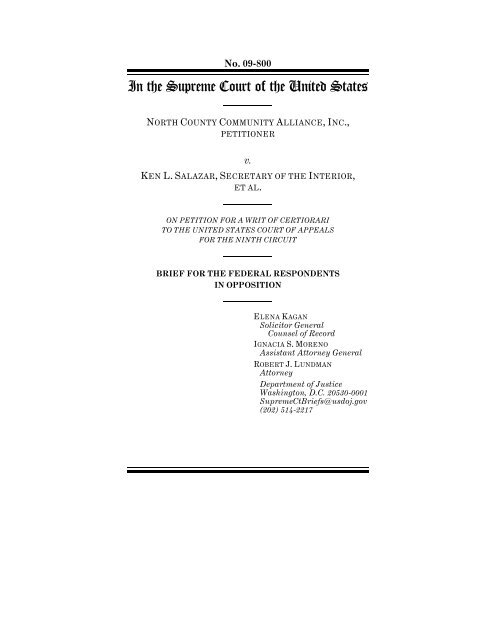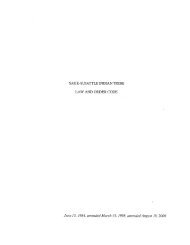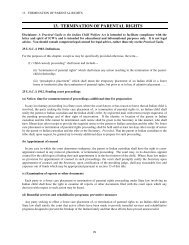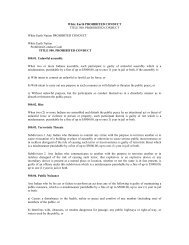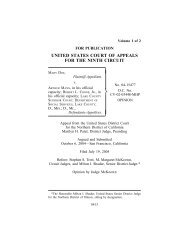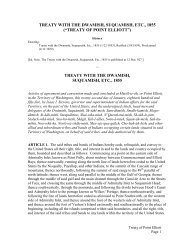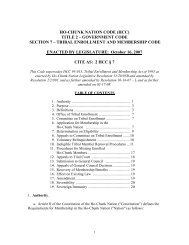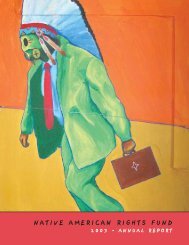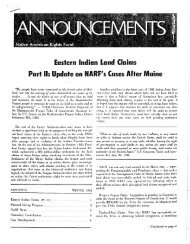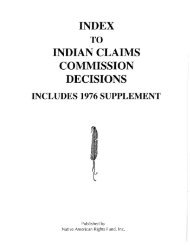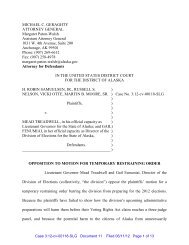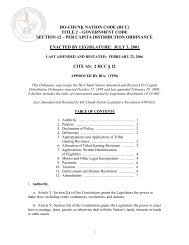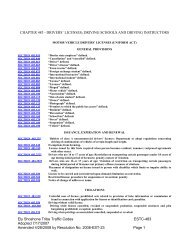View PDF Version - Department of Justice
View PDF Version - Department of Justice
View PDF Version - Department of Justice
Create successful ePaper yourself
Turn your PDF publications into a flip-book with our unique Google optimized e-Paper software.
No. 09-800In the Supreme Court <strong>of</strong> the United StatesNORTH COUNTY COMMUNITY ALLIANCE, INC.,PETITIONERv.KEN L. SALAZAR, SECRETARY OF THE INTERIOR,ET AL.ON PETITION FOR A WRIT OF CERTIORARITO THE UNITED STATES COURT OF APPEALSFOR THE NINTH CIRCUITBRIEF FOR THE FEDERAL RESPONDENTSIN OPPOSITIONELENA KAGANSolicitor GeneralCounsel <strong>of</strong> RecordIGNACIA S. MORENOAssistant Attorney GeneralROBERT J. LUNDMANAttorney<strong>Department</strong> <strong>of</strong> <strong>Justice</strong>Washington, D.C. 20530-0001SupremeCtBriefs@usdoj.gov(202) 514-2217
QUESTION PRESENTEDWhether the Indian Gaming Regulatory Act, 25U.S.C. 2701 et seq., requires that a tribal gaming ordinanceinclude the location <strong>of</strong> a potential gaming site, andthat the National Indian Gaming Commission determinethat the site qualifies as “Indian lands” before approvingthe ordinance.(I)
TABLE OF CONTENTSPageOpinions below........................................ 1Jurisdiction........................................... 1Statement ............................................ 2Argument ............................................ 6Conclusion .......................................... 11Cases:TABLE OF AUTHORITIESApache Tribe v. United States, No. 04-1184,2007 WL 2071874 (W.D. Okla. July 18, 2007) ........ 10Bates v. United States, 522 U.S. 23 (1997) .............. 8Citizens Against Casino Gambling in Erie Countyv. Kempthorne, 471 F. Supp. 2d 295 (W.D.N.Y.2007), amended on recons. on other grounds,No. 06-CV-0001S, 2007 WL 1200473 (W.D.N.Y.Apr. 20, 2007) ................................... 10FDA v. Brown & Williamson Tobacco Corp.,529 U.S. 120 (2000) ............................... 9Heckler v. Chaney, 470 U.S. 821 (1985) ................ 10Ragsdale v. Wolverine World Wide, Inc.,535 U.S. 81 (2002) ................................ 9Wind River Mining Corp. v. United States,946 F.2d 710 (9th Cir. 1991) ..................... 5, 11Statutes, regulations and rules:Gambling Devices Transportation Act, 15 U.S.C. 1171et seq. .......................................... 8Indian Gaming Regulatory Act, Pub. L. No. 100-497,102 Stat. 2467 (25 U.S.C. 2701 et seq.) ............... 2(III)
IVStatutes, regulations and rules—Continued:Page25 U.S.C. 2702(1) .............................. 225 U.S.C. 2703(4) .............................. 325 U.S.C. 2703(6) .............................. 225 U.S.C. 2703(7) .............................. 225 U.S.C. 2703(8) .............................. 225 U.S.C. 2710(a)(1) ............................ 225 U.S.C. 2710(a)(2) ............................ 225 U.S.C. 2710(b) .............................. 225 U.S.C. 2710(b)(1) ........................... 225 U.S.C. 2710(b)(2) .......................... 2, 625 U.S.C. 2710(b)(2)(E) ......................... 725 U.S.C. 2710(d) .............................. 225 U.S.C. 2710(d)(1)(A) ......................... 225 U.S.C. 2710(d)(1)(A)(ii) ....................... 225 U.S.C. 2710(d)(3) ............................ 225 U.S.C. 2713 ................................. 825 U.S.C. 2716(b) .............................. 825 U.S.C. 2719(a) .............................. 325 U.S.C. 2719(b) .............................. 328 U.S.C. 2401(a) ................................ 4, 11Amendments to Various Indian National GamingCommission Regulations, 74 Fed. Reg. 36,940(2009) (to be codified at 25 C.F.R. 573.6(a)(13)) ....... 825 C.F.R.:Section 502.12 ................................... 3Section 522.2(i) ................................... 9Section 559.1(a) .................................. 9
VRegulations and rules—Continued:PageSection 559.2(a) .................................. 9Section 573.6(a)(12) ............................... 7Section 573.6(a)(13) ............................... 8Fed. R. Civ. P.:Rule 12(b)(1) .................................... 4Rule 12(b)(6) .................................... 4Sup. Ct. R. 10(a) ................................... 10Miscellaneous:Approval <strong>of</strong> Class III Tribal Gaming Ordinances,58 Fed. Reg. 65,406 (1993) ......................... 3Environment, Public Health and Safety,67 Fed. Reg. 46,109 (2002) ......................... 7National Indian Gaming Comm’n, Facility LicenseStandards, 73 Fed. Reg. (2008):p. 6019 ....................................... 9p. 6022 ....................................... 2
In the Supreme Court <strong>of</strong> the United StatesNo. 09-800NORTH COUNTY COMMUNITY ALLIANCE, INC.,PETITIONERv.KEN L. SALAZAR, SECRETARY OF THE INTERIOR,ET AL.ON PETITION FOR A WRIT OF CERTIORARITO THE UNITED STATES COURT OF APPEALSFOR THE NINTH CIRCUITBRIEF FOR THE FEDERAL RESPONDENTSIN OPPOSITIONOPINIONS BELOWThe opinion <strong>of</strong> the court <strong>of</strong> appeals (Pet. App. 1-31)is reported at 573 F.3d 738. The opinion <strong>of</strong> the districtcourt (Pet. App. 32-53) is unreported.JURISDICTIONThe judgment <strong>of</strong> the court <strong>of</strong> appeals was entered onJuly 15, 2009. A petition for rehearing was denied onOctober 6, 2009 (Pet. App. 54-55). The petition for a writ<strong>of</strong> certiorari was filed on January 4, 2010. The jurisdiction<strong>of</strong> this Court is invoked under 28 U.S.C. 1254(1).(1)
2STATEMENT1. a. The Indian Gaming Regulatory Act (IGRA),Pub. L. No. 100-497, 102 Stat. 2467 (25 U.S.C. 2701 etseq.), was enacted in 1988 “to provide a statutory basisfor the operation <strong>of</strong> gaming by Indian tribes as ameans <strong>of</strong> promoting tribal economic development, selfsufficiency,and strong tribal governments.” 25 U.S.C.2702(1). IGRA establishes three classes <strong>of</strong> gaming.Class I gaming, which consists <strong>of</strong> social games for prizes<strong>of</strong> minimal value and traditional games engaged in aspart <strong>of</strong> tribal ceremonies or celebrations, is subject tothe exclusive regulatory control <strong>of</strong> Indian Tribes. 25U.S.C. 2703(6), 2710(a)(1). Class II gaming, which includesbingo and similar games, and Class III gaming,which includes slot machines and blackjack, are subjectto federal regulation under IGRA. 25 U.S.C. 2703(7)and (8), 2710(a)(2), (b) and (d).Under IGRA, a Tribe that wishes to conduct Class IIor III gaming must, among other things, submit a tribalgaming ordinance for approval by the Chairman <strong>of</strong> theNational Indian Gaming Commission (NIGC). 25 U.S.C.2710(b)(2) and (d)(1)(A). IGRA requires the NIGCChairman to approve a Class II or Class III gaming ordinanceif the ordinance satisfies a number <strong>of</strong> specificconditions relating to ownership and control <strong>of</strong> the gaming,use <strong>of</strong> gaming revenues, audits, protection <strong>of</strong> theenvironment and public health and safety, and backgroundinvestigations. 25 U.S.C. 2710(b)(2); see 25U.S.C. 2710(d)(1)(A)(ii).b. IGRA applies only to gaming on “Indian lands.”25 U.S.C. 2710(b)(1) (Class II) and 2710(d)(3) (ClassIII); NIGC, Facility License Standards, 73 Fed. Reg.6022 (2008) (final rule) (“IGRA requires that all gamingtake place on ‘Indian lands.’ Gaming that does not take
3place on Indian lands is subject to all state and localgambling laws and federal laws apart from IGRA.”) (citationomitted). The statute defines “Indian lands” as:(A) all lands within the limits <strong>of</strong> any Indian reservation;and (B) any lands title to which is either held intrust by the United States for the benefit <strong>of</strong> any Indiantribe or individual or held by any Indian tribe orindividual subject to restriction by the United Statesagainst alienation and over which an Indian tribeexercises governmental power.25 U.S.C. 2703(4); see also 25 C.F.R. 502.12.Gaming generally may not be conducted on certain“Indian lands”—namely, Indian lands acquired in trustfor the benefit <strong>of</strong> a Tribe after October 17, 1988. 25U.S.C. 2719(a). That general prohibition is, however,subject to certain exceptions. 25 U.S.C. 2719(a) and (b).2. In 1993, the Nooksack Tribe, a federally recognizedIndian Tribe with a reservation in northwesternWashington, submitted a Class II and Class III tribalgaming ordinance to the NIGC for approval. Pet. App.3. The Tribe’s ordinance did not specify a particular siteor sites where the gaming would occur, but instead, asrelevant here, provided that the Nooksack Gaming Commissionwould “issue a separate license to each place,facility, or location on Indian lands where Class II gamingis conducted under this ordinance.” Id. at 4. TheNIGC approved the ordinance. Id. at 3; Approval <strong>of</strong>Class III Tribal Gaming Ordinances, 58 Fed. Reg.65,406 (1993). 11The ordinance and the NIGC Chairman’s letter approvingthe ordinance are available at http://www.nigc.gov/Portals/0/NIGC%20Uploads/readingroom/gamingordinances/nooksack/nooksackord102793.pdf.
4Shortly after the NIGC approved the ordinance, theNooksack Tribe established a Class III gaming facilityon its reservation in Deming, Washington. Pet. App. 4.That facility is not at issue in this case.In 2006, the Tribe licensed and began building a secondgaming facility called the Northwood Crossing Casino.Pet. App. 4. The Casino is located approximately33 miles by road from the Nooksack reservation, on landthat the United States had taken into trust for the Tribein 1984. Pet. App. 4, 34; Pet. 5; see Gov’t C.A. Br. 34n.17.3. In July 2007, petitioner filed suit against respondentsin the United States District Court for the WesternDistrict <strong>of</strong> Washington. Pet. App. 5, 34. Petitionerclaimed, among other things, that respondents violatedIGRA by failing to determine—either in 1993 when theNooksack ordinance was approved or in 2006 when theTribe licensed and began constructing the NorthwoodCrossing Casino—that the land on which the Casino wasbuilt is Indian land. Id. at 5.The district court dismissed the complaint with prejudiceunder Federal Rules <strong>of</strong> Civil Procedure 12(b)(1)and (6). Pet. App. 32-53. The court held that petitioner’schallenge to NIGC’s 1993 approval <strong>of</strong> theTribe’s gaming ordinance was barred by the applicablesix-year statute <strong>of</strong> limitations, 28 U.S.C. 2401(a). Pet.App. 36-43. The court further rejected petitioner’s argumentthat IGRA required respondents to make a formalIndian lands determination before the construction<strong>of</strong> the Casino in 2006. Id. at 44-50.4. The court <strong>of</strong> appeals affirmed. Pet. App. 1-24. Asan initial matter, the court held that neither petitioner’schallenge to the 1993 approval <strong>of</strong> the gaming ordinancenor its challenge to respondents’ failure to make an In-
5dian lands determination before the Casino was built in2006 was barred by the applicable statute <strong>of</strong> limitations.Id. at 6-9. The court reasoned that petitioner’s claimthat the NIGC acted ultra vires by failing to make anIndian lands determination in 1993 did not accrue untilpetitioner “took an interest” in the issue in 2006. Id. at9 (citing Wind River Mining Corp. v. United States, 946F.2d 710, 715 (9th Cir. 1991)).On the merits, the court <strong>of</strong> appeals held that respondents“did not have a duty under IGRA to make an Indianlands determination in 1993 before approving theNooksacks’ non-site-specific proposed gaming Ordinance.”Pet. App. 3. The court noted that nothing in thetext <strong>of</strong> IGRA requires a Tribe to submit a site-specificgaming ordinance as a precondition for NIGC approval,id. at 13, 17, and that “in practice most gaming ordinancesapproved by the NIGC do not identify specificsites,” id. at 18. Absent a statutory obligation to identifyspecific sites in a proposed ordinance, the court reasonedthat “it would be absurdly impractical to requireNIGC to make an Indian lands determination as part <strong>of</strong>its approval <strong>of</strong> an ordinance.” Id. at 17.The court <strong>of</strong> appeals further held that respondents“did not have a duty under IGRA to make an Indianlands determination before 2006 when the Nooksackslicensed and began construction <strong>of</strong> the Casino pursuantto the approved Ordinance,” Pet. App. 3, explaining thatnothing in IGRA’s text or applicable regulations imposedsuch a requirement, id. at 18-19.The court <strong>of</strong> appeals acknowledged that IGRA andthe regulations in effect at the times relevant to petitioner’slawsuit could potentially lead to a Tribe operatinga Class II gaming facility on non-Indian land pursuantto a non-site-specific gaming ordinance. Pet. App.
619. The court noted, however, that the NIGC has statutoryauthority to order the closure <strong>of</strong> a facility locatedon land not eligible for gaming under IGRA, id. at 21-22,and that the NIGC had recently promulgated regulationsdesigned to facilitate eligibility determinationsbefore gaming facilities are opened, id. at 19-20.Judge Gould dissented in part. He would have heldthat NIGC was required to make an Indian lands determinationbefore construction <strong>of</strong> the Casino began in2006. Pet. App. 24-31.ARGUMENTPetitioner contends (Pet. 11-18) that IGRA requiresrespondents to make an Indian lands determination beforeapproving a Tribe’s gaming ordinance. The court <strong>of</strong>appeals correctly rejected that contention, and its decisiondoes not conflict with any decision <strong>of</strong> this Court or<strong>of</strong> any other court <strong>of</strong> appeals. Further review is unwarranted.1. As the court <strong>of</strong> appeals correctly explained (Pet.App. 12), IGRA requires the Chairman <strong>of</strong> the NIGC toapprove a proposed tribal ordinance concerning Class IIgaming if the ordinance meets certain specified conditionsrelating to ownership and control <strong>of</strong> the gaming,use <strong>of</strong> gaming revenues, audits, protection <strong>of</strong> the environmentand public health and safety, and backgroundinvestigations. 25 U.S.C. 2710(b)(2). IGRA does not requirea Tribe to specify a particular site or sites in itsproposed gaming ordinance. Ibid.; see Pet. App. 17.Nor does IGRA require the NIGC to determine, beforeapproving the ordinance, that any and all possible siteson which the Tribe might conduct gaming qualify as eligibleIndian land within the meaning <strong>of</strong> the statute. Seeibid. (rejecting that notion as “absurdly impractical”).
7Petitioner identifies one provision <strong>of</strong> IGRA, 25U.S.C. 2710(b)(2)(E), that it claims “rather plainly contemplates”site-specific approval <strong>of</strong> gaming ordinancesbased on an Indian lands determination. Pet. 15. Thatprovision requires that a Tribe’s ordinance provide that“the construction and maintenance <strong>of</strong> the gaming facility,and the operation <strong>of</strong> that gaming is conducted in amanner which adequately protects the environment andthe public health and safety.” 25 U.S.C. 2710(b)(2)(E).That provision <strong>of</strong> IGRA, however, does not so much asmention “Indian lands,” much less does it require a preapprovalIndian lands determination.Nor, contrary to petitioner’s argument (Pet. 15), doesSection 2710(b)(2)(E) require a site-specific determinationwhether the “construction” <strong>of</strong> a particular gamingfacility—not to mention the facility’s “maintenance” or“operation”—is being conducted in an environmentallyresponsible and safe manner before the NIGC approvesthe ordinance that would authorize the gaming in question.Section 2710(b)(2)(E) simply requires that a gamingordinance provide for the environmentally responsibleand safe construction, maintenance, and operation <strong>of</strong>any gaming facilities established pursuant to the ordinance.Once a gaming facility is established pursuant toan approved ordinance, NIGC regulations provide forperiodic environmental, public health, and safety reviewspursuant to its enforcement authority over ongoinggaming operations. 25 C.F.R. 573.6(a)(12); Environment,Public Health and Safety, 67 Fed. Reg. 46,109(2002) (interpretive rule).2. Petitioner contends (Pet. 13-14) that, even ifIGRA contains no explicit requirement that the NIGCmake an Indian lands determination before approving atribal gaming ordinance, such a requirement is implicit
8in the statute, which applies only to gaming on Indianlands. This Court, however, “ordinarily resist[s] readingwords or elements into a statute that do not appear onits face.” Bates v. United States, 522 U.S. 23, 29 (1997).Petitioner <strong>of</strong>fers no persuasive reason to deviate fromthat rule in this case.In any event, while it is true that IGRA applies onlyto gaming on Indian lands, it does not follow that IGRAforbids the NIGC from approving non-site-specific gamingordinances like the Nooksack Tribe’s. As the court<strong>of</strong> appeals noted (Pet. App. 21-22), IGRA provides forother means <strong>of</strong> enforcing the statute’s Indian lands limitationonce an ordinance has been approved. If a Tribeopens a gaming facility on a site that is ineligible forgaming under IGRA, then the statute authorizes theNIGC to take enforcement action, including orderingclosure <strong>of</strong> the gaming facility. 25 U.S.C. 2713; see Pet.App. 21; see also Amendments to Various National IndianGaming Commission Regulations, 74 Fed. Reg.36,940 (2009) (to be codified at 25 C.F.R. 573.6(a)(13))(providing that NIGC Chairman may issue order <strong>of</strong> temporaryclosure <strong>of</strong> a gaming facility on Indian lands noteligible for gaming under IGRA).IGRA also directs the NIGC to report informationindicating a violation <strong>of</strong> Federal, State, or Tribal law tothe appropriate law enforcement <strong>of</strong>ficials. 25 U.S.C.2716(b). If the NIGC determines that a gaming sitedoes not qualify as Indian land under IGRA, then theNIGC may refer the matter to state <strong>of</strong>ficials or federalprosecutors. See Pet. App. 21-22; see also Gambling DevicesTransportation Act, 15 U.S.C. 1171 et seq. (criminalizingsome transportation and possession <strong>of</strong> gamblingdevices).
9Petitioner contends (Pet. 17-18) that those enforcementmechanisms undermine the statutory goals <strong>of</strong>tribal economic development and self-sufficiency. Butnothing in IGRA prevents Tribes from seeking site-specificapprovals before commencing construction. Andnotably, the NIGC has recently promulgated regulationsto facilitate review <strong>of</strong> Indian lands issues well beforenew facilities are opened. 73 Fed. Reg. at 6019; see Pet.App. 19-20. The new regulations authorize the Chairmanto request documentation concerning the Indianlands information when the Tribe submits a proposedordinance. 25 C.F.R. 522.2(i). The regulations also requirea Tribe to notify the NIGC before opening a newgaming facility, 25 C.F.R. 559.1(a), and to provide siteinformation necessary to determine whether the propertyis eligible for gaming under IGRA, 25 C.F.R.559.2(a).3. Petitioner errs in asserting (Pet. 11-13) that thecourt <strong>of</strong> appeals’ decision conflicts with this Court’scases holding that an agency may not exceed the powerconferred on it by Congress. See Pet. 11-12 (discussingRagsdale v. Wolverine World Wide, Inc., 535 U.S. 81(2002), and FDA v. Brown & Williamson Tobacco Corp.,529 U.S. 120 (2000)). It is true that, under IGRA, theNIGC’s authority is limited to the regulation <strong>of</strong> gamingon Indian lands. But when the NIGC approves a nonsite-specificgaming ordinance, it does not thereby authorizegaming on non-Indian lands that are beyond itsregulatory authority. Indeed, the ordinance the NIGCapproved in this case expressly affirmed that each gamingfacility opened under the ordinance would be located“on Indian lands.” Pet. App. 4.The question petitioner raises ultimately does notconcern the scope <strong>of</strong> the NIGC’s statutory power, but
10the scope <strong>of</strong> its discretion to decide how to enforceIGRA’s Indian lands limitation. As noted above, afteran ordinance is approved, the NIGC retains enforcementauthority to shut down gaming that occurs on Indianlands that are not eligible for gaming, and may refergaming that occurs on non-Indian lands to the appropriatelaw enforcement <strong>of</strong>ficials. See p. 8, supra. In petitioner’sview, however, the NIGC must enforce IGRA’sIndian lands limitation in a different way—namely, byinsisting that Tribes submit site-specific ordinances, andby making site-specific Indian lands determinations beforeapproving the ordinances—even though, by itsterms, IGRA imposes no such requirements. Nothing inthe cases petitioner cites supports such a limitation onthe NIGC’s regulatory and enforcement discretion. Cf.Heckler v. Chaney, 470 U.S. 821, 831 (1985) (noting thatenforcement decisions are “generally committed to anagency’s absolute discretion”). 22Petitioner also contends (Pet. 18-21) that the court <strong>of</strong> appeals’ decisionconflicts with two district court decisions. Any such conflict wouldnot merit this Court’s review. See Sup. Ct. R. 10(a). In any event, boththe gaming ordinance at issue in Citizens Against Casino Gambling inErie County v. Kempthorne, 471 F. Supp. 2d 295 (W.D.N.Y. 2007) (ErieCounty), amended on recons. on other grounds, No. 06-CV-0001S, 2007WL 1200473 (W.D.N.Y. Apr. 20, 2007), and the tribal-state compact atissue in Apache Tribe v. United States, No. 04-1184, 2007 WL 2071874(W.D. Okla. July 18, 2007) (unpublished), concerned legal documentsthat were considerably more site-specific than the ordinance at issue inthis case. See Pet. App. 14-16 (distinguishing Erie County); see alsoApache Tribe, 2007 WL 2071874, at *1. The decision below, by contrast,held that the NIGC has no statutory duty to conduct an Indian landsdetermination before approving an ordinance in which “no potentialgaming sites are identified, either specifically or generally.” Pet. App.15-16.
114. Finally, petitioner’s challenge to the NIGC’s approval<strong>of</strong> a non-site-specific ordinance raises questions<strong>of</strong> timeliness under the applicable six-year statute <strong>of</strong>limitations. See 28 U.S.C. 2401(a). Although the NIGCapproved the Nooksack Tribe’s ordinance in 1993, petitionersdid not file suit until 2007. To address the questionpetitioner presents thus would require this Court toconsider whether, as the district court held (Pet. App.36-43), petitioner raised its challenge too late, or whether,as the court <strong>of</strong> appeals held, the limitations clock didnot start to run until petitioner “took an interest” in theissue in 2006. See id. at. 6-10 (citing Wind River MiningCorp. v. United States, 946 F.2d 710, 715 (9th Cir.1991)). For that reason as well, further review is notwarranted.CONCLUSIONThe petition for a writ <strong>of</strong> certiorari should be denied.Respectfully submitted.MARCH 2010ELENA KAGANSolicitor GeneralIGNACIA S. MORENOAssistant Attorney GeneralROBERT J. LUNDMANAttorney


